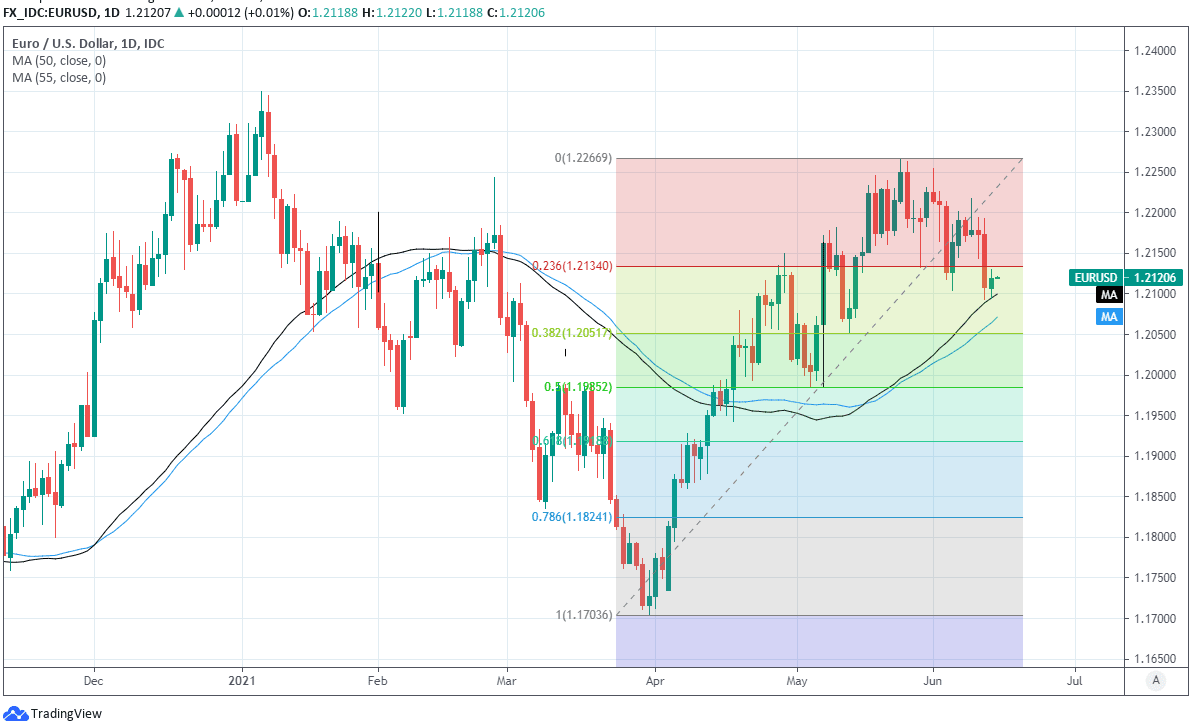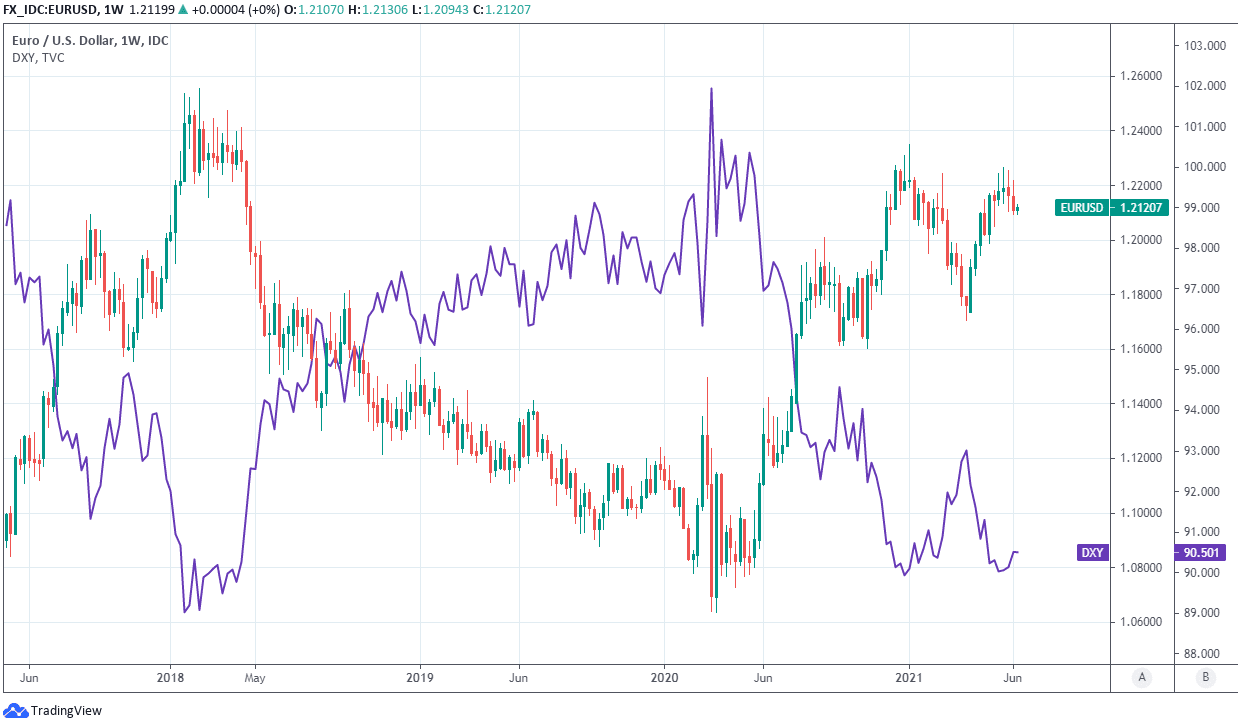Euro-Dollar Builds Support but Fed’s Shadow Darkens Horizon
- Written by: James Skinner
- EUR/USD supported at 1.2050 and 1.21
- But 1.2218, 1.2266 obstruct road north
- As Fed casts tall shadow, taper talk looms
- Though China’s FX buying begins this week

Image © Adobe Images
- EUR/USD reference rates at publication:
- Spot: 1.2144
- Bank transfers (indicative guide): 1.1748-1.1833
- Money transfer specialist rates (indicative): 1.2064-1.2089
- More information on securing specialist rates, here
- Set up an exchange rate alert, here
The Euro-to-Dollar exchange rate has dug in its heels above 1.21 in recent days while benefiting from a double-barrelled and nearby technical support on the charts, although its path higher is overshadowed this week by risks stemming from Federal Reserve (Fed) monetary policy.
Europe’s unified unit has held mostly above 1.21 during June’s ongoing correction higher in U.S. exchange rates, during which Euro-Dollar has held up comparatively well including when rebounding swiftly last Friday and again on Monday from its 50-day moving average around 1.2095.
While the above-referenced level remained intact on Tuesday, the Euro was also potentially underpinned further down by the 55-day average at 1.2064 and a Fibonacci retracement level located around 1.2050, all of which offer at least a modicum of technical support to the single currency.
“A fall through the next lower 1.2052 mid-May low on a daily chart closing basis would probably trigger a deeper retracement to the 1.1994/86 band of support (mid-March highs and April 22 as well as May lows) which should ideally hold the downside,” says Axel Rudolph, a senior technical analyst at Commerzbank.
“Only a currently unexpected bullish reversal above last week’s high at 1.2218 would re-engage the 1.2266 end of May high, which guards the 1.2349 January high,” Rudolph says.
The Euro-to-Dollar exchange rate is well supported on the charts and could be aided in what is a quiet week for homegrown influences by an early June decision from the Peoples’ Bank of China (PBoC) to raise the foreign exchange reserve ratio requirement of domestic lenders.
Above: Euro-Dollar at daily intervals with Fibonacci retracements of April recovery and 21 as well as 55-day averages.
Secure a retail exchange rate that is between 3-5% stronger than offered by leading banks, learn more.
That was effective from Monday 14 June, a bank holiday in China, and is basically an instruction for lenders to buy foreign currencies in an amount that analysts estimate could be worth around $20 billion.
It’s less clear now whether such lenders would buy Euros, Dollars or other currencies although the main event for the Euro-Dollar rate in the week ahead is Wednesday’s 19:00 policy decision from the Fed.
"While there may be scope for some disappointment for the USD on the event, we would expect this to be short-lived. We see scope for EUR/USD to test 1.20 this summer in anticipation that the tapering discussion at the Fed will soon begin in earnest," says Jane Foley, a senior FX strategist at Rabobank.
"ECB President Lagarde made it clear last week that there will be no change in the central bank’s asset purchase programme just yet. In terms of inflation risk, this has historically run cooler in the Eurozone than in the US," Foley adds.
No change to either the Federal Funds rate or its $120bn quantitative easing (QE) programme is expected this month although the market will scrutinise the dot-plot of policymakers’ projections for future interest rates closely for clues as to whether higher borrowing costs and increased investor returns are likely to materialise much before the earlier indicated time of 2024.
{wbamp-hide start} {wbamp-hide end}{wbamp-show start}{wbamp-show end}
Exchange rates will also listen closely for any changes to the Fed’s guidance on the future of its QE programme, which buys $80BN of U.S. government bonds per month and $40BN of mortgage bonds.
This is especially important to the Euro and Dollar given that many investors have long expected a tapering or steady winding up of the programme to begin around year-end and also after several of the bank’s senior policymakers recently suggested it may soon begin talking about exactly this.
“Should the FOMC not un-nerve markets, we would look for EUR/USD to be pushing higher towards the end of the week,” says Chris Turner, global head of markets and regional head of research at ING.
Any tapering would mean less pressure on U.S. bond yields and could potentially give the Dollar a lift if those yields rise sufficiently to draw in outside investors, the anticipation of which may have to do with why the greenback has risen against most counterparts this June
But there is a risk of disappointment for the Dollar, which would be supportive of EUR/USD in the latter half of the week, given that policymakers who suggested they might soon be minded to discuss dialling down the QE programme did so before the May non-farm payrolls report at the beginning of this month.
Above: Euro-Dollar at weekly intervals with U.S. Dollar Index.
The May employment report revealed job growth of more than 500k which would’ve been cause for a real celebration in pre-pandemic times, although the outcome was in reality less than the 645k anticipated by the consensus and still leaves the Fed a long way short of the “substantial further progress” it has been wanting to see before considering a change to its QE programme.
This could potentially lead the Fed Chairman Jerome Powell to adopt on Wednesday a position that is not too dissimilar to that taken by the European Central Bank (ECB) last week when President Christine Lagarde welcomed progress in containing the coronavirus and reopening economies but stressed that it’s too soon for the bank to curtail its supportive policy programmes due to lingering risks to the recovery.
“The ECB made it plain again last Thursday that it will continue to err on the side of caution despite an improving economic outlook and a near-term spike in inflation beyond its previous estimates. This Wednesday, the US Fed will probably follow suit, raising its inflation projections without shifting the policy outlook by much,” says Holger Schmieding, chief economist at Berenberg.
“That the Fed will likely announce this week that it will discuss a strategy to taper its asset purchases at its subsequent meetings seems to be priced in. Whereas central banks on both sides of the Atlantic will almost certainly adjust their policy stance later this year to reflect the strong economic rebound and the prospect for a gradual rise in underlying inflation, the risk that they would overdo it and derail the economic recovery within the next two years still seems remote,” Schmieding says.






